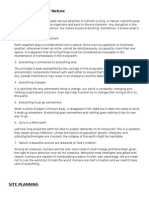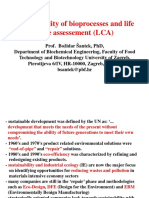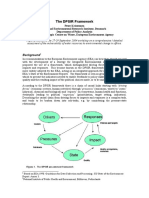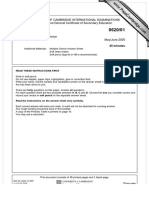0 ratings0% found this document useful (0 votes)
43 viewsMETLAND - Metropolitan Landscape Planning Model - : An Evaluation &implementation Model
METLAND - Metropolitan Landscape Planning Model - : An Evaluation &implementation Model
Uploaded by
Ar Deepika RajaThe Metropolitan Landscape Planning Model (METLAND) is an evaluation and implementation model for assessing special resources, hazards, and development suitability in metropolitan landscapes. It was developed by an interdisciplinary team at the University of Massachusetts to address the problems caused by metropolitanization around Boston, such as depletion of resources and development on marginal lands. The METLAND model proposes a three-phase planning process involving assessment, evaluation, and implementation. The assessment phase involves quantifying and mapping variables across four components: special resources, hazards, development suitability, and ecological stability. These maps are used to evaluate tradeoffs and identify environmental issues to inform land use decisions. The goal is to incorporate economic and ecological factors into decision making at a metropolitan scale.
Copyright:
© All Rights Reserved
Available Formats
Download as PPTX, PDF, TXT or read online from Scribd
METLAND - Metropolitan Landscape Planning Model - : An Evaluation &implementation Model
METLAND - Metropolitan Landscape Planning Model - : An Evaluation &implementation Model
Uploaded by
Ar Deepika Raja0 ratings0% found this document useful (0 votes)
43 views15 pagesThe Metropolitan Landscape Planning Model (METLAND) is an evaluation and implementation model for assessing special resources, hazards, and development suitability in metropolitan landscapes. It was developed by an interdisciplinary team at the University of Massachusetts to address the problems caused by metropolitanization around Boston, such as depletion of resources and development on marginal lands. The METLAND model proposes a three-phase planning process involving assessment, evaluation, and implementation. The assessment phase involves quantifying and mapping variables across four components: special resources, hazards, development suitability, and ecological stability. These maps are used to evaluate tradeoffs and identify environmental issues to inform land use decisions. The goal is to incorporate economic and ecological factors into decision making at a metropolitan scale.
Original Description:
synopsis
Original Title
dissertation
Copyright
© © All Rights Reserved
Available Formats
PPTX, PDF, TXT or read online from Scribd
Share this document
Did you find this document useful?
Is this content inappropriate?
The Metropolitan Landscape Planning Model (METLAND) is an evaluation and implementation model for assessing special resources, hazards, and development suitability in metropolitan landscapes. It was developed by an interdisciplinary team at the University of Massachusetts to address the problems caused by metropolitanization around Boston, such as depletion of resources and development on marginal lands. The METLAND model proposes a three-phase planning process involving assessment, evaluation, and implementation. The assessment phase involves quantifying and mapping variables across four components: special resources, hazards, development suitability, and ecological stability. These maps are used to evaluate tradeoffs and identify environmental issues to inform land use decisions. The goal is to incorporate economic and ecological factors into decision making at a metropolitan scale.
Copyright:
© All Rights Reserved
Available Formats
Download as PPTX, PDF, TXT or read online from Scribd
Download as pptx, pdf, or txt
0 ratings0% found this document useful (0 votes)
43 views15 pagesMETLAND - Metropolitan Landscape Planning Model - : An Evaluation &implementation Model
METLAND - Metropolitan Landscape Planning Model - : An Evaluation &implementation Model
Uploaded by
Ar Deepika RajaThe Metropolitan Landscape Planning Model (METLAND) is an evaluation and implementation model for assessing special resources, hazards, and development suitability in metropolitan landscapes. It was developed by an interdisciplinary team at the University of Massachusetts to address the problems caused by metropolitanization around Boston, such as depletion of resources and development on marginal lands. The METLAND model proposes a three-phase planning process involving assessment, evaluation, and implementation. The assessment phase involves quantifying and mapping variables across four components: special resources, hazards, development suitability, and ecological stability. These maps are used to evaluate tradeoffs and identify environmental issues to inform land use decisions. The goal is to incorporate economic and ecological factors into decision making at a metropolitan scale.
Copyright:
© All Rights Reserved
Available Formats
Download as PPTX, PDF, TXT or read online from Scribd
Download as pptx, pdf, or txt
You are on page 1of 15
METLAND– Metropolitan Landscape Planning Model – an
evaluation &implementation model.
A landscape planning model for metros for assessing
1. special resources,
2. hazards(natural and man-made) &
3. development suitability
Computer mapping helps in the quantitative and spatial
mapping of resultant assessments
METLAND - a framework for incorporating economic
evaluations of resources, hazards &development suitability's
into land use decisions
HISTORY
Interdisciplinary Landscape research team (over 3 0 people)
- at the University of Massachusetts, U.S.A. in 1 9 7 1 –
developed the Metropolitan Landscape Planning Model
(METLAND)
Applied the Model to Burlington town in the larger Boston
Metropolitan Area ( 2 5 0 0 square miles) mapping 2 0 yrs. of
Metropolitanization
Problem of “Metropolitanization of eastern Massachusetts”
had caused
•a needlessly high depletion of environmental / landscape
resources,
•increased hazards &
•development often on marginally suitable lands
Metropolitinization – has impaired vital ecological stability of large
landscape units
Important step – quantify this phenomena &place them on equal terms
with other quantified “Values” in the decision making process
Highways &other major public installations - major growth generators
Planners have hardly taken the ecological aspect into account for their
design
Boston - 8 0 % developed with modern industries, shopping centres &
low density housing
METLAND team – “attention of decision makers on the resulting
landscape issues would be better if the scale of the negative
consequences of their actions were assessed, quantified &highlighted”
Research done – attempt to place economic values on several resource
variables Other possible areas of research
•Evaluation on energy use analysis
•Perception of conservationists &developers
FRAMEWORKOF THEMETLANDMODEL
Proposes a 3-phase planning model
1.Assessment phase
2.Evaluation phase
3.Implementation phase
Assessment phase consists of a selection of variables analyzing the
intrinsic value of those environmental characteristics which may benefit or
harm society
These are mapped &organized into 4 groups called components
Every individual variable has a specific value &the grouping helps us
identify complimentary relationships and environmental issues . The
combined values are helpful in decision making.
4 components of assessment phase
1.Special resources
2.Hazards
3.Development suitability
4.Ecological Stability
SPECIALRESOURCES COMPONENT – addresses environmental resources
&deals with
1.Renewable physical resources e.g. Water critical to Metros
2.Non-renewable physical resources e.g. Sand
3.“Aesthetic-cultural” resources e.g. Views - enhances quality of life
Individual special resources / variables FIRST TYPE
•Agricultural productivity
•Wildlife productivity – open land, wood land, wet land - wild life sub
variables
•Water resources SECOND TYPE
•Sand &Gravel supply THIRD TYPE
•Visual Landscape quality – quality wetland areas, views and historical sites
•Visual contrast
•Diversity &compatibility of land uses
HAZARD COMPONENT – adresses environmental dangers or
undesirabilities 3 environmental variables
1.Air pollution
2.Noise pollution
3.Flooding Gives both the type &magnitude of the hazard
DEVELOPMENT SUITABILITY COMPONENT – addresses environmental
opportunities for alternative types of development. Opportunities are
landscape resources that can minimize the cost of development while
increasing human comfort &user amenities.
3 variables
1.Physical variable
2.Topo-climate variable
3.Visual variable To enhance suitability &attractiveness of an area of
development
ECOLOGICALSTABILITYCOMPONENT – addresses ecological impact,
ecosystem structure and function &implications of these in land-use
decisions 3 environmental variables
1.Air pollution
2.Noise pollution
3.Flooding Gives both the type &magnitude of the hazard
MAPPING SYSTEM The COMLUP - Computer Mapping for Land-Use
Planning developed by Dr. Neil Allen of the U.S.D.A. Forest Dept. Has 2 5
programs with provision for inventory, overlay &line plotting of spatially
located source data
You might also like
- Cdra Compilation SampleDocument19 pagesCdra Compilation SampleTere YalongNo ratings yet
- Report Eia Environmental GeologyDocument67 pagesReport Eia Environmental GeologyZULKARNAIN BIN ZAINUDDIN BS20110317No ratings yet
- Review 1 - Dissertation PDFDocument9 pagesReview 1 - Dissertation PDFAr Deepika RajaNo ratings yet
- Water Quality Assessment PR2 FinalDocument22 pagesWater Quality Assessment PR2 FinalPeteisaiah CopadaNo ratings yet
- TP GeotechniqueDocument20 pagesTP GeotechniqueToto ToualiNo ratings yet
- BCIL Tzed Homes Case StudyDocument3 pagesBCIL Tzed Homes Case StudyShubham Udoshi100% (1)
- Eia 1Document15 pagesEia 1dg0231131No ratings yet
- Eia C1&C2Document27 pagesEia C1&C2Rajukumar KumarNo ratings yet
- Environmental Impact AssessmentDocument37 pagesEnvironmental Impact AssessmentAbdul KarimNo ratings yet
- Envi PDFDocument3 pagesEnvi PDFAsha JNo ratings yet
- Envi PDFDocument3 pagesEnvi PDFAmit DostNo ratings yet
- Environmental Studies SylaDocument3 pagesEnvironmental Studies SylaTharun DGNo ratings yet
- Environmental Studies: Course ObjectivesDocument3 pagesEnvironmental Studies: Course ObjectivesHemanth KumarNo ratings yet
- Eia UnitoDocument12 pagesEia UnitoFede BrunoNo ratings yet
- Chapter 2 The Environmental Planning ProcessDocument55 pagesChapter 2 The Environmental Planning ProcessTole DelúxëNo ratings yet
- Kalyanpur Municipality: Government of Nepal Office of The Municipal Executive Province-2, Kalyanpur, SirahaDocument9 pagesKalyanpur Municipality: Government of Nepal Office of The Municipal Executive Province-2, Kalyanpur, SirahaVivek yadavNo ratings yet
- Environmental StudiesDocument3 pagesEnvironmental StudiespavanNo ratings yet
- EIA MethodologiesDocument26 pagesEIA MethodologiesRevo D CreaterNo ratings yet
- EraDocument84 pagesEra37bearbearNo ratings yet
- 7 Laws of Nature (Lecture Notes by Arch't Ryan Cabanlit)Document4 pages7 Laws of Nature (Lecture Notes by Arch't Ryan Cabanlit)Mark HisolerNo ratings yet
- Evs PDFDocument3 pagesEvs PDFMd Mohioddin MohiNo ratings yet
- Assignment of The Environment and DevelopmentDocument33 pagesAssignment of The Environment and DevelopmentSagar SunuwarNo ratings yet
- Assignment of The Environment and DevelopmentDocument33 pagesAssignment of The Environment and DevelopmentSagar SunuwarNo ratings yet
- TNC Target Viability WorksheetDocument8 pagesTNC Target Viability WorksheettontonukNo ratings yet
- Unit-7 Environment Impact Assessment (EIA)Document45 pagesUnit-7 Environment Impact Assessment (EIA)Prà ShâñtNo ratings yet
- Topic 2Document26 pagesTopic 2Nor SyalwanisNo ratings yet
- Chapter 5 Eia New 2019Document72 pagesChapter 5 Eia New 2019ainsahNo ratings yet
- Masters Course in Planning (Specialization in ENVIRONMENTAL PLANNING) Mission StatementDocument8 pagesMasters Course in Planning (Specialization in ENVIRONMENTAL PLANNING) Mission StatementJho Manalastas AlpayNo ratings yet
- Environmental Impact AssessmentDocument28 pagesEnvironmental Impact AssessmentSelvakumar VelayuthamNo ratings yet
- Intro To CDRA - April 25Document33 pagesIntro To CDRA - April 25mmasacalNo ratings yet
- Terrain Evaluation For Highway EngineeringDocument97 pagesTerrain Evaluation For Highway EngineeringሚካኤልመኮንንNo ratings yet
- Appendix A: Watershed AnalysisDocument42 pagesAppendix A: Watershed AnalysisCharles MaffraNo ratings yet
- Contextualizacion de La Evalucion de Impacto AmbientalDocument4 pagesContextualizacion de La Evalucion de Impacto AmbientalVivianaGaitanNo ratings yet
- Impact Assessment of Land Use Planning-CIBIN J DASDocument9 pagesImpact Assessment of Land Use Planning-CIBIN J DASOmjinath SureshNo ratings yet
- Randi Arman Pratama - Land Resource Midterm ExamDocument3 pagesRandi Arman Pratama - Land Resource Midterm ExamRandi Arman PratamaNo ratings yet
- Eia1 1Document43 pagesEia1 1adrinampaulmiscNo ratings yet
- Unit - 1 - Basic Concepts of EIADocument21 pagesUnit - 1 - Basic Concepts of EIAdivyaintworkNo ratings yet
- Eia PSDPDocument90 pagesEia PSDPNnapnNo ratings yet
- Designing Sustainable Natural Resources Utilization SchemePlan (L - IV)Document10 pagesDesigning Sustainable Natural Resources Utilization SchemePlan (L - IV)FelekePhiliphos100% (1)
- Impact Prediction and Assessment - Soil EnvironmentDocument22 pagesImpact Prediction and Assessment - Soil EnvironmentAshutosh PrabhuNo ratings yet
- 1523277457paper10 Module29 EtextDocument13 pages1523277457paper10 Module29 Etext1ankitabeheraNo ratings yet
- EIA Unit-I NotesDocument19 pagesEIA Unit-I Notescehv117204No ratings yet
- 3 Studies and Tasks Required For A Full Environmental Assessment ReportDocument9 pages3 Studies and Tasks Required For A Full Environmental Assessment ReportchileNo ratings yet
- Sustainability of Bioprocesses and Life Cycle Assessement (LCA)Document48 pagesSustainability of Bioprocesses and Life Cycle Assessement (LCA)MarinaNo ratings yet
- ToR For IEE of Riverbed ExtractionDocument7 pagesToR For IEE of Riverbed ExtractionGt MadanNo ratings yet
- Site Analysis FrameworkDocument9 pagesSite Analysis Frameworkbisrat meseretNo ratings yet
- MIT1 011S11 Lec02Document19 pagesMIT1 011S11 Lec02Timotei BolojanNo ratings yet
- Environmental Subject SyllabusDocument6 pagesEnvironmental Subject SyllabusManojKumar MNo ratings yet
- Environmental Risks of Economic DevelopmentDocument5 pagesEnvironmental Risks of Economic Developmentapi-343698254No ratings yet
- DPSIR OverviewDocument10 pagesDPSIR OverviewAaron WoodardNo ratings yet
- Green Growth-PresentationDocument83 pagesGreen Growth-PresentationAlfrainerNo ratings yet
- eHM2 Chapter 7 1ADocument40 pageseHM2 Chapter 7 1AJennifer AcedoNo ratings yet
- FybcomevsstudyDocument279 pagesFybcomevsstudyKapil Gajbhiye60% (10)
- Enviornmental ScienceDocument6 pagesEnviornmental ScienceSharan ShivaNo ratings yet
- Module 01 2023 Env. Man - Question Bank With Main Points For StudentsDocument13 pagesModule 01 2023 Env. Man - Question Bank With Main Points For StudentsSEONA DABRE202025No ratings yet
- Rapid EIADocument37 pagesRapid EIAYaswanth SinhaNo ratings yet
- Published2012 - 44 123 1 PBDocument8 pagesPublished2012 - 44 123 1 PBNantha KumaranNo ratings yet
- E1 - 3RD - Aspects of Site DesignDocument23 pagesE1 - 3RD - Aspects of Site DesignWENDY GALGONo ratings yet
- Climate Compensatory FunctionDocument10 pagesClimate Compensatory FunctionSandra JiménezNo ratings yet
- DPSIR FrameworkDocument10 pagesDPSIR FrameworkNigel HopeNo ratings yet
- Ma 9161 MathematicsDocument11 pagesMa 9161 Mathematicsasvin1992No ratings yet
- Managing Climate Risks in Coastal Communities: Strategies for Engagement, Readiness and AdaptationFrom EverandManaging Climate Risks in Coastal Communities: Strategies for Engagement, Readiness and AdaptationNo ratings yet
- Climate Exodus: A Statistical Analysis of Displacements and Projections Towards an Uncertain Future: Research published in English, #4From EverandClimate Exodus: A Statistical Analysis of Displacements and Projections Towards an Uncertain Future: Research published in English, #4No ratings yet
- Urban Stormwater: Best-Practice Environmental Management GuidelinesFrom EverandUrban Stormwater: Best-Practice Environmental Management GuidelinesNo ratings yet
- Indian CasestudyDocument23 pagesIndian CasestudyAr Deepika RajaNo ratings yet
- Grassland Landscape ManagementDocument22 pagesGrassland Landscape ManagementAr Deepika RajaNo ratings yet
- Landscape Site StandardsDocument153 pagesLandscape Site StandardsAr Deepika RajaNo ratings yet
- 1 Dissertation Review-1 - Campus LandscapeDocument12 pages1 Dissertation Review-1 - Campus LandscapeAr Deepika RajaNo ratings yet
- Chemistry P1Document13 pagesChemistry P1zachaeusNo ratings yet
- Space in Our Lives: Outline in This Section You'll Learn To..Document23 pagesSpace in Our Lives: Outline in This Section You'll Learn To..Santiago HidalgoNo ratings yet
- Yavuz Et Al 2010 - Thermal Effect On The Physical Properties of Carbonate Rocks-AnnotatedDocument10 pagesYavuz Et Al 2010 - Thermal Effect On The Physical Properties of Carbonate Rocks-AnnotatedJul JulNo ratings yet
- Dielectric Properties and AC Conductivity of (EpoxyDocument10 pagesDielectric Properties and AC Conductivity of (EpoxyAlexander DeckerNo ratings yet
- Mind Mapping 9 Satria Krisnanda PDFDocument1 pageMind Mapping 9 Satria Krisnanda PDFMade Satria Krisnanda PujawanNo ratings yet
- Earth and Life Science: Self Learning ModuleDocument10 pagesEarth and Life Science: Self Learning ModuleJerry De Leon TaayNo ratings yet
- Seafloor Spreading TheoryDocument16 pagesSeafloor Spreading TheoryMark Anthony Evangelista Cabrieto100% (1)
- Ceramics International: Mahamoud S. Alkathy, Rahul Gayam, K.C. James RajuDocument10 pagesCeramics International: Mahamoud S. Alkathy, Rahul Gayam, K.C. James RajuRachna SelvamaniNo ratings yet
- The Evolution of MatterDocument482 pagesThe Evolution of Matteranakin68100% (8)
- Datasheet Bioo Panel ENGDocument2 pagesDatasheet Bioo Panel ENGaryan100% (1)
- Psychrometrics - Theory and Examples PDFDocument45 pagesPsychrometrics - Theory and Examples PDFmarjan 01No ratings yet
- Matter in Our Surroundings NotesDocument5 pagesMatter in Our Surroundings NotesRajesh Kumar GuptaNo ratings yet
- SLA 2 Science 9 Physics 4th QuarterDocument15 pagesSLA 2 Science 9 Physics 4th QuarterNymphaNarvasaDecasaNo ratings yet
- Basic Knowledge and Skills of Fire Safety Requirements For Electrical Engineering (0531)Document90 pagesBasic Knowledge and Skills of Fire Safety Requirements For Electrical Engineering (0531)Susi SusilowatiNo ratings yet
- Environmental Awareness - BSED E2B GROUP 10Document24 pagesEnvironmental Awareness - BSED E2B GROUP 10Ma. Adelfa ApipiNo ratings yet
- University of Cambridge International Examinations International General Certificate of Secondary Education Chemistry Paper 1 Multiple Choice May/June 2005 45 MinutesDocument16 pagesUniversity of Cambridge International Examinations International General Certificate of Secondary Education Chemistry Paper 1 Multiple Choice May/June 2005 45 MinutesFranca OkechukwuNo ratings yet
- Dry-Out and Heat-Up Procedures - 2015 WorkshopDocument30 pagesDry-Out and Heat-Up Procedures - 2015 WorkshopyuriNo ratings yet
- LTspice-model of Thermoelectric Peltier-Seebeck ElementDocument5 pagesLTspice-model of Thermoelectric Peltier-Seebeck ElementVinicius Silva OliveiraNo ratings yet
- SCES3083 Topic 5 FluidDocument44 pagesSCES3083 Topic 5 Fluid胡佳玲No ratings yet
- Physics Upthrust NotesDocument33 pagesPhysics Upthrust NotesHarshwardhan UndeNo ratings yet
- MAG LEVintroductionDocument3 pagesMAG LEVintroductionlance galorportNo ratings yet
- X Steam For MatlabDocument5 pagesX Steam For Matlabshane5ul100% (1)
- Spacial Relativity McqsDocument14 pagesSpacial Relativity McqsMuhammad Noman Hameed100% (1)
- Scenario of Global Health Course-Paw-2018Document9 pagesScenario of Global Health Course-Paw-2018Hilmy Bravianto KartonoNo ratings yet
- Sustainable LifestyleDocument5 pagesSustainable Lifestylevagrace.orzalNo ratings yet





























































































